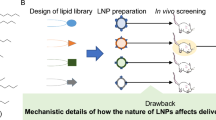Abstract
Lipid formulations for cell transfection are among the most efficient systems for nucleic acid delivery. During the COVID-19 pandemic, lipid-encapsulated RNA (lipid nanoparticles, LNP) has succeeded as a superior vaccine. Moreover, other similar lipid nanocarriers for siRNA are approved and many are on the pipelines. While lipid encapsulation required several devices for the mixing of components, lipoplex technology allows to rapidly mix nucleic acids and positively charged lipids for cell transfection. In vivo, hepatocytes are important target cells of lipid formulated RNAi. This chapter describes the state-of-the-art lipoplex and LPN manufacturing for treating primary hepatocytes with lipid formulations. Furthermore, protocols for isolating murine hepatocytes and for transfecting these cells with pharmaceutically relevant lipid formulations are provided and discussed.
Access this chapter
Tax calculation will be finalised at checkout
Purchases are for personal use only
Similar content being viewed by others
References
Leber N, Nuhn L, Zentel R (2017) Cationic nanohydrogel particles for therapeutic oligonucleotide delivery. Macromol Biosci 17(10). https://doi.org/10.1002/mabi.201700092
Liu Q, Lyu Z, Yu Y, Zhao ZA, Hu S, Yuan L, Chen G, Chen H (2017) Synthetic glycopolymers for highly efficient differentiation of embryonic stem cells into neurons: lipo- or not? ACS Appl Mater Interfaces 9(13):11518–11527. https://doi.org/10.1021/acsami.7b01397
Xue H, Lin F, Tan H, Zhu ZQ, Zhang ZY, Zhao L (2016) Overrepresentation of IL-10-expressing B cells suppresses cytotoxic CD4+ T cell activity in HBV-induced hepatocellular carcinoma. PLoS One 11(5):e0154815. https://doi.org/10.1371/journal.pone.0154815
Woitok MM, Zoubek ME, Doleschel D, Bartneck M, Mohamed MR, Kiessling F, Lederle W, Trautwein C, Cubero FJ (2020) Lipid-encapsulated siRNA for hepatocyte-directed treatment of advanced liver disease. Cell Death Dis 11(5):343. https://doi.org/10.1038/s41419-020-2571-4
Akinc A, Querbes W, De S, Qin J, Frank-Kamenetsky M, Jayaprakash KN, Jayaraman M, Rajeev KG, Cantley WL, Dorkin JR, Butler JS, Qin L, Racie T, Sprague A, Fava E, Zeigerer A, Hope MJ, Zerial M, Sah DW, Fitzgerald K, Tracy MA, Manoharan M, Koteliansky V, Fougerolles A, Maier MA (2010) Targeted delivery of RNAi therapeutics with endogenous and exogenous ligand-based mechanisms. Mol Ther 18(7):1357–1364. https://doi.org/10.1038/mt.2010.85
Suhr OB, Coelho T, Buades J, Pouget J, Conceicao I, Berk J, Schmidt H, Waddington-Cruz M, Campistol JM, Bettencourt BR, Vaishnaw A, Gollob J, Adams D (2015) Efficacy and safety of patisiran for familial amyloidotic polyneuropathy: a phase II multi-dose study. Orphanet J Rare Dis 10:109. https://doi.org/10.1186/s13023-015-0326-6
Wadhwa A, Aljabbari A, Lokras A, Foged C, Thakur A (2020) Opportunities and challenges in the delivery of mRNA-based vaccines. Pharmaceutics 12(2). https://doi.org/10.3390/pharmaceutics12020102
Bartneck M (2021) Lipid nanoparticle formulations for targeting leukocytes with therapeutic RNA in liver fibrosis. Adv Drug Deliv Rev 173:70–88. https://doi.org/10.1016/j.addr.2021.03.009
Danaei M, Dehghankhold M, Ataei S, Hasanzadeh Davarani F, Javanmard R, Dokhani A, Khorasani S, Mozafari MR (2018) Impact of particle size and polydispersity index on the clinical applications of lipidic nanocarrier systems. Pharmaceutics 10(2):doi:10.3390/pharmaceutics10020057
Cheng X, Lee RJ (2016) The role of helper lipids in lipid nanoparticles (LNPs) designed for oligonucleotide delivery. Adv Drug Deliv Rev 99(Pt A):129–137. https://doi.org/10.1016/j.addr.2016.01.022
Scioli Montoto S, Muraca G, Ruiz ME (2020) Solid lipid nanoparticles for drug delivery: pharmacological and biopharmaceutical aspects. Front Mol Biosci 7:587997. https://doi.org/10.3389/fmolb.2020.587997
Delehedde C, Even L, Midoux P, Pichon C, Perche F (2021) Intracellular routing and recognition of lipid-based mRNA nanoparticles. Pharmaceutics 13(7):doi:10.3390/pharmaceutics13070945
Wahane A, Waghmode A, Kapphahn A, Dhuri K, Gupta A, Bahal R (2020) Role of lipid-based and polymer-based non-viral vectors in nucleic acid delivery for next-generation gene therapy. Molecules 25(12):doi:10.3390/molecules25122866
Kim M, Jeong M, Hur S, Cho Y, Park J, Jung H, Seo Y, Woo HA, Nam KT, Lee K, Lee H (2021) Engineered ionizable lipid nanoparticles for targeted delivery of RNA therapeutics into different types of cells in the liver. Sci Adv 7(9). https://doi.org/10.1126/sciadv.abf4398
Acknowledgments
This research was supported by the MINECO Retos PID2020-117941RB-IOO, SAF2016-78711, and SAF2017-87919-R, MINECO PID2019-104878RB-100AEI/10.13039/501100011033, by Comunidad de Madrid (S2017/BMD-3727 EXOHEP-CM and Y2018/NMT-4949 NanoLiver-CM), and co-funded by European Structural and Investment Fund, ERAB Ref. EA 18/14, AMMF 2018/117, UCM-25-2019, the German Research Foundation (SFB/TRR57/P04, SFB 1382-403224013/A02 and DFG NE 2128/2-1), and COST Action CA17112. YAN and FJC are Ramón y Cajal Researcher RYC-2015-17438 and RYC-2014-15242, respectively. FJC is a Gilead Liver Research 2018. The research group belongs to the validated Research Groups Ref. 970935 ¨Liver Pathophysiology¨, 920631 ¨Lymphocyte immunobiology¨, 920361 “Inmunogenética e inmunología de las mucosas” and IBL-6 (imas12-associated).
Author information
Authors and Affiliations
Corresponding author
Editor information
Editors and Affiliations
Rights and permissions
Copyright information
© 2022 The Author(s), under exclusive license to Springer Science+Business Media, LLC, part of Springer Nature
About this protocol
Cite this protocol
Morán, L., Woitok, M.M., Bartneck, M., Cubero, F.J. (2022). Hepatocyte-Directed Delivery of Lipid-Encapsulated Small Interfering RNA. In: Tanimizu, N. (eds) Hepatocytes. Methods in Molecular Biology, vol 2544. Humana, New York, NY. https://doi.org/10.1007/978-1-0716-2557-6_6
Download citation
DOI: https://doi.org/10.1007/978-1-0716-2557-6_6
Published:
Publisher Name: Humana, New York, NY
Print ISBN: 978-1-0716-2556-9
Online ISBN: 978-1-0716-2557-6
eBook Packages: Springer Protocols




